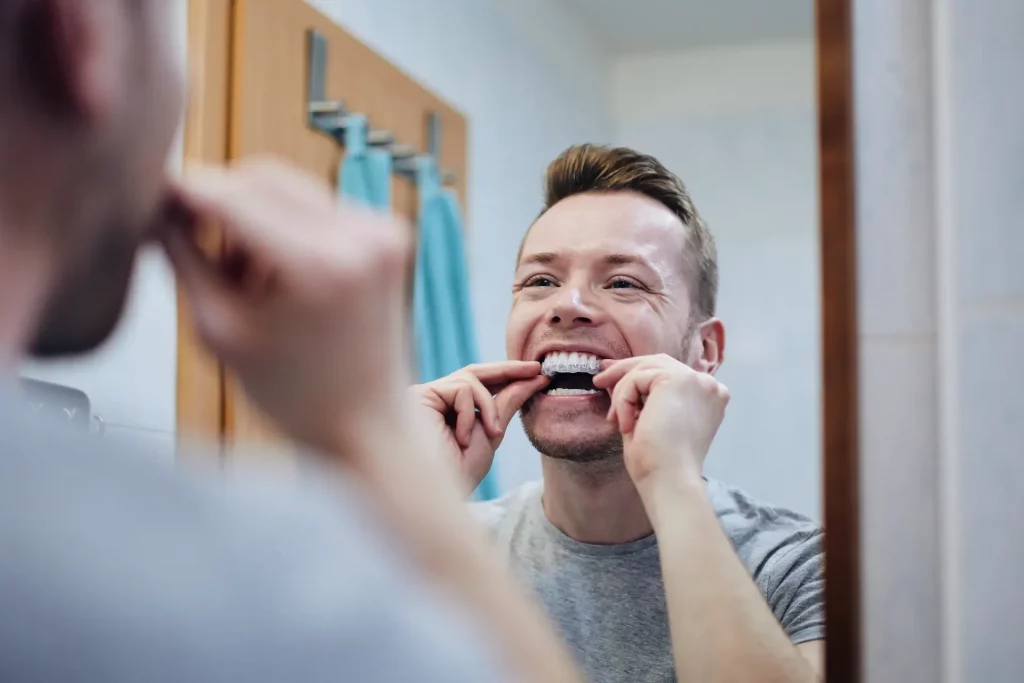The question we hear most often about Invisalign from our Allen & Fairview patients is whether or not it hurts. Those who have gone through traditional metal brace treatments know that the pain may never be intense, but there’s certainly some pain to be expected. Invisalign is advertised as being pain-free and, at the very least, less painful than metal braces. While Invisalign can help you get a smile you’ll love, it’s not always a pain-free process.
You can expect some discomfort and pain during treatment as your teeth adjust to being straightened. Believe it or not, mild discomfort is actually a good thing, as it means your teeth are being guided to their correct positions. So you’re wondering how much does Invisalign treatment hurt? And how can you make that pain go away? Here’s what you need to know about the slight discomfort associated with Invisalign treatment and how long it lasts, along with tips for relieving any discomfort you might feel during your treatment.

Invisalign is a very comfortable orthodontic treatment option. In fact, Invisalign may be more comfortable than traditional metal braces, which can cause a lot of pain as they work to push your teeth into place. But getting Invisalign doesn’t necessarily mean you’ll escape pain-free. It’s common for the first couple of weeks with any new set of aligners to be uncomfortable, and it’s also not unusual for your gums and lips to become sore from having an object in your mouth all day. The discomfort you experience goes away as your teeth adjust to the clear aligners as the aligners adjust to your teeth.
As long as these symptoms don’t linger or become worse over time, they’re just signs that your mouth is adjusting to the aligners. The important thing is not to let it stop you from using your Invisalign trays!
Feel like your Invisalign trays is causing you some pain? Here are some ways to alleviate the pain while you receive your aligner treatment.

When you’re sore from your Invisalign aligners, it can be tempting to take them out to get some relief. But if you want the soreness to go away as fast as possible, our best advice for getting over the soreness is to keep wearing your clear aligners. We know this can sound like a pain—but it’s really going to help! Leaving your aligner will help you get used to it faster and get the aligner doing its job sooner.
If you’re experiencing pain and discomfort, or swelling, an ice pack is a simple way to help. Just place the ice pack directly on the area of pain or swelling for up to 10 minutes at a time. You can repeat this as often as needed throughout the day. Make sure to wrap your ice pack in a cloth before placing it directly on your skin. Another alternative is to try drinking some cold water or sucking on some ice cubes, which can also help numb the area affected.
It’s no fun to deal with soreness, especially from your new aligners. While it’s not the most comfortable experience, we’ve got a great trick to help you through those first few hours.
New aligners tend to cause the most soreness in the first hours after you put them in. When patients receive their new aligners, we recommend our Sloan Creek Dental patients wear their new aligners at night. You’ll be able to sleep through the initial discomfort and make your way through the next day without having to experience it while you’re wide awake.
Your teeth may feel sensitive at the beginning of any new aligner tray. To give them a chance to adjust, it’s a good idea to focus on soft foods for the first couple of days. By “soft” we mean foods like ice cream, yogurt, mashed potatoes, pasta, and rice. Trust us—your teeth will thank you. Avoid eating crunchy foods as they may make the soreness in your teeth worse.

When you put your aligner in, snap it into place and push it all the way so that it’s flush against your teeth. It should feel pretty snug—that’s how you know you’ve got it in correctly. If you don’t get it in all the way, it can put unnecessary pressure on your teeth and cause some discomfort. Your teeth will feel like they’re being pulled into a position that doesn’t quite fit.
If you rub your tongue along the edge of the aligner and it feels like it’s cutting or poking you, or if it just feels like it has rough edges against your tongue, this is a concern that you should tell our office. The problem can be easily remedied by telling us where the rough or sharp edge is, and we can smooth it out.
If you want some relief, try applying Orajel. It’s a topical pain killer that will temporarily numb the affected area. Just take out your clear aligners and use it directly on the spot that hurts.
We know over-the-counter pain medication can be tempting, but hang in there! If you’re feeling discomfort after your Invisalign treatment, listening to your body is the best thing to do. Take it easy, drink plenty of water, and get plenty of rest.
If you’re still in pain, you can take over-the-counter pain medicine, such as ibuprofen or acetaminophen, if it’s necessary. But first, we recommend trying the advice mentioned above. Even if you’re experiencing discomfort, it’s usually manageable for most patients without any over-the-counter medication.
For many new Invisalign users, wearing the aligners may result in some discomfort. Just like when you first started wearing your retainer or night guard, you might have to get used to your new mouth accessory. As you get used to having something in your mouth all day, and as your teeth shift, you may find that the pain lessens. If, after a few months of using Invisalign, the pain hasn’t subsided or become much less severe, talk to your dentist for further advice.
A 2020 study assessing adults wearing traditional braces and Invisalign found that those in the group with traditional metal braces reported more pain overall. People in the first group were also more likely to need medication for pain relief during the first week of wearing metal braces.
Everyone has a different pain tolerance, and if your goal is to have straighter teeth in a shorter time with less pain than traditional braces, then Invisalign is the preferred choice. The overwhelming majority of patients who chose Invisalign over traditional braces reported that they’re glad they did, and we think you will be too.
If you experience tooth sensitivity on one tooth after using a new aligner, this is normal, and is just a sign that the aligners are working—they’re gradually moving your teeth into the right spot. The temporary pain you feel may not be in the same tooth for every aligner, and the pain should ease up within a few days.
Getting Invisalign can be a little painful sometimes. But the end result is always worth it! You’ll look back at the experience and think, “That wasn’t so bad.” Even though your teeth might’ve hurt a little, you know you’re getting one step closer to that perfect healthier smile!

If you’re interested in correcting crooked teeth for a beautiful smile, give our dentist in the Allen & Fairview area a call. Our experienced dentist and team can help you navigate the process from beginning to end and go over your treatment options.
You can reach us at our Fairview, TX dental office to schedule an in-person consultation with us today – 972-468-1440. Our dental office is located in Fairview, Texas, and our patients visit us from across the surrounding areas, including Allen, Plano, McKinney, and Lucas.
We firmly believe that the internet should be available and accessible to anyone, and are committed to providing a website that is accessible to the widest possible audience, regardless of circumstance and ability.
To fulfill this, we aim to adhere as strictly as possible to the World Wide Web Consortium’s (W3C) Web Content Accessibility Guidelines 2.1 (WCAG 2.1) at the AA level. These guidelines explain how to make web content accessible to people with a wide array of disabilities. Complying with those guidelines helps us ensure that the website is accessible to all people: blind people, people with motor impairments, visual impairment, cognitive disabilities, and more.
This website utilizes various technologies that are meant to make it as accessible as possible at all times. We utilize an accessibility interface that allows persons with specific disabilities to adjust the website’s UI (user interface) and design it to their personal needs.
Additionally, the website utilizes an AI-based application that runs in the background and optimizes its accessibility level constantly. This application remediates the website’s HTML, adapts Its functionality and behavior for screen-readers used by the blind users, and for keyboard functions used by individuals with motor impairments.
If you’ve found a malfunction or have ideas for improvement, we’ll be happy to hear from you. You can reach out to the website’s operators by using the following email
Our website implements the ARIA attributes (Accessible Rich Internet Applications) technique, alongside various different behavioral changes, to ensure blind users visiting with screen-readers are able to read, comprehend, and enjoy the website’s functions. As soon as a user with a screen-reader enters your site, they immediately receive a prompt to enter the Screen-Reader Profile so they can browse and operate your site effectively. Here’s how our website covers some of the most important screen-reader requirements, alongside console screenshots of code examples:
Screen-reader optimization: we run a background process that learns the website’s components from top to bottom, to ensure ongoing compliance even when updating the website. In this process, we provide screen-readers with meaningful data using the ARIA set of attributes. For example, we provide accurate form labels; descriptions for actionable icons (social media icons, search icons, cart icons, etc.); validation guidance for form inputs; element roles such as buttons, menus, modal dialogues (popups), and others. Additionally, the background process scans all of the website’s images and provides an accurate and meaningful image-object-recognition-based description as an ALT (alternate text) tag for images that are not described. It will also extract texts that are embedded within the image, using an OCR (optical character recognition) technology. To turn on screen-reader adjustments at any time, users need only to press the Alt+1 keyboard combination. Screen-reader users also get automatic announcements to turn the Screen-reader mode on as soon as they enter the website.
These adjustments are compatible with all popular screen readers, including JAWS and NVDA.
Keyboard navigation optimization: The background process also adjusts the website’s HTML, and adds various behaviors using JavaScript code to make the website operable by the keyboard. This includes the ability to navigate the website using the Tab and Shift+Tab keys, operate dropdowns with the arrow keys, close them with Esc, trigger buttons and links using the Enter key, navigate between radio and checkbox elements using the arrow keys, and fill them in with the Spacebar or Enter key.Additionally, keyboard users will find quick-navigation and content-skip menus, available at any time by clicking Alt+1, or as the first elements of the site while navigating with the keyboard. The background process also handles triggered popups by moving the keyboard focus towards them as soon as they appear, and not allow the focus drift outside of it.
Users can also use shortcuts such as “M” (menus), “H” (headings), “F” (forms), “B” (buttons), and “G” (graphics) to jump to specific elements.
We aim to support the widest array of browsers and assistive technologies as possible, so our users can choose the best fitting tools for them, with as few limitations as possible. Therefore, we have worked very hard to be able to support all major systems that comprise over 95% of the user market share including Google Chrome, Mozilla Firefox, Apple Safari, Opera and Microsoft Edge, JAWS and NVDA (screen readers), both for Windows and for MAC users.
Despite our very best efforts to allow anybody to adjust the website to their needs, there may still be pages or sections that are not fully accessible, are in the process of becoming accessible, or are lacking an adequate technological solution to make them accessible. Still, we are continually improving our accessibility, adding, updating and improving its options and features, and developing and adopting new technologies. All this is meant to reach the optimal level of accessibility, following technological advancements. For any assistance, please reach out to